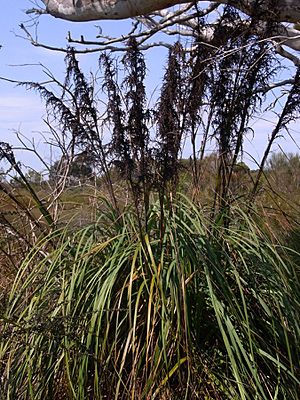Red-fruit saw-sedge facts for kids
Quick facts for kids Red-fruit saw-sedge |
|
|---|---|
 |
|
| Ku-ring-gai Chase National Park, Australia | |
| Scientific classification | |
| Genus: |
Gahnia
|
| Species: |
sieberiana
|
The red-fruit saw-sedge (scientific name: Gahnia sieberiana) is a cool plant from Australia. It grows in a big clump, like a bunch of grass. This plant is a perennial, which means it lives for more than two years. It's found only in Australia, making it endemic to the country. You can often spot it in sunny, damp places. Many different insect larvae like to munch on its leaves. This plant can grow super tall, sometimes over 2 meters (about 6.5 feet)!
Contents
What is the Red-Fruit Saw-Sedge?
The red-fruit saw-sedge is a type of sedge. Sedges are grass-like plants, but they belong to a different plant family called Cyperaceae. This plant forms a large, dense clump, which botanists call a tussock. It's known for its long, rough leaves and its interesting red fruits.
How Was It Discovered?
A German scientist named Carl Sigismund Kunth first described Gahnia sieberiana in 1837. The plant's second name, sieberiana, honors a Bohemian collector named Franz Wilhelm Sieber. Many plants are named after the people who discover or study them!
What Does It Look Like?
The red-fruit saw-sedge grows as a tall, leafy clump. It can reach up to 2 meters (6.5 feet) high and just as wide. Its leaves are flat and feel rough to the touch. Be careful when you handle them! The edges of the leaves have tiny, sharp teeth. These can easily cut your hands if you're not careful.
Flowers and Fruits
In spring and summer, tall black flower spikes grow from the center of the plant. These spikes can stand another meter (3 feet) above the leafy clump. After the flowers, the plant produces shiny, round nuts. These nuts are usually red or reddish-brown. They are small, about 2.5 to 4 millimeters (0.1 to 0.16 inches) long. They are also about 1.5 to 2 millimeters (0.06 to 0.08 inches) wide.
Where Does the Red-Fruit Saw-Sedge Live?
You can find Gahnia sieberiana all over eastern Australia. It grows from the island of Tasmania up to North Queensland. It also lives in a region called Malesia. This plant is very adaptable. It can grow from sea level all the way up to mountains 1200 meters (about 3,900 feet) high. It doesn't mind if the soil is clay or sandy.
Life Cycle and Animal Friends
The seeds of the red-fruit saw-sedge seem to sprout well after a bushfire. This shows how tough and adapted to its environment this plant is.
Who Eats This Plant?
Many different caterpillars love to eat the leaves of the red-fruit saw-sedge. These include:
- The dingy grass-skipper (Toxidia peron)
- The montane sedge-skipper (Oreisplanus perornata)
- The silver sedge-skipper (Hesperilla crypsargyra)
- The flame sedge-skipper (Hesperilla idothea)
- The golden-haired sedge-skipper (Hesperilla chrysotricha)
- The heath sand-skipper (Antipodia chaostola)
- The sword-grass brown (Tisiphone abeona)
- The northern sword-grass brown (Tisiphone helena)
These butterflies and moths rely on the saw-sedge for food when they are young.
Red-Fruit Saw-Sedge in Gardens
In Australian gardens, the red-fruit saw-sedge is a great choice. It's a native plant that can be used instead of pampas grass (Cortaderia selloana). Pampas grass is considered a harmful weed in Australia.
It can be a bit tricky to grow new plants from the seeds of the red-fruit saw-sedge. But you can easily make more plants by dividing the existing clumps. This means splitting a large plant into smaller pieces, and each piece can grow into a new plant.

